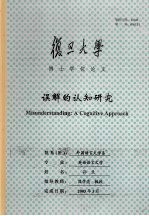
Chapter 1 Introduction 1
1.1 Preamble 1
1.2 Rationale and objectives 1
1.3 Data collection 3
1.4 Research scope and methodology 5
1.5 Outline of the dissertation 5
Chapter 2 Previous Work on Misunderstanding 7
2.1 Introduction 7
2.2 Various approaches to misunderstanding 7
2.2.1 Pragmatics-centered approach 7
2.2.2 Conversation-analytic approach 8
2.2.3 Computational-linguistic approach 9
2.2.4 Cross-cultural approach 10
2.2.5 Misunderstanding in institutional settings 11
2.2.6 Study of misunderstanding in China 13
2.3 Definition of misunderstanding 14
2.3.1 Misunderstanding as a common sense category 15
2.3.2 Misunderstanding and its"family" 16
2.3.2.1 Misunderstanding vs.miscommunication 16
2.3.2.2 Misunderstanding vs.other forms of miscommunication 17
2.3.2.3 Misunderstanding vs.pragmatic failure 19
2.3.2.4 Summary 19
2.3.3 Various aspects of defining misunderstanding 20
2.4 Levels or types of misunderstanding 22
2.4.1 Misunderstanding on levels of linguistic analysis 23
2.4.2 Misunderstanding on levels of meaning 23
2.4.3 Relevance-theoretic classification 25
2.4.4 Classification based on recognition and negotiation 26
2.4.5 Result-based classification 28
2.5 Sources of misunderstanding 27
2.5.1 Sources related to the nature of communication 28
2.5.2 Sources related to communicative means—language 31
2.5.2.1 Ambiguity and vagueness 32
2.5.2.2 Implicitness and indirectness 34
2.5.2.3 Jargon 35
2.5.3 Sources related to communicators 36
2.5.3.1 Expectations and inferences 36
2.5.3.2 Language transfer 38
2.6 Conclusion 39
Chapter 3 Theoretical Framework 40
3.1 Introduction 40
3.2 Triggers in the previous work 40
3.3 Objectivist theories of understanding 42
3.3.1 The conduit model of understanding 42
3.3.2 Pragmatic theories of understanding 42
3.3.3 Insufficiencies of objectivist theories of understanding 45
3.4 An experiential view of understanding 47
3.4.1 Basic assumptions of experientialism 47
3.4.2 An outline of experiential understanding 49
3.4.2.1 Perception of the world 49
3.4.2.2 Organization of the perceived world 52
3.4.2.3 ICMs and language use(understanding) 56
3.5 Assumptions of ICMs-based misunderstanding 58
3.6 Conclusion 59
Chapter 4 Misunderstanding and ICMs'Conflict 60
4.1 Introduction 60
4.2 Outline of ICMs'conflict 60
4.3 Misunderstanding and experiences'conflict 63
4.3.1 Individual experience vs.individual experience 63
4.3.2 Individual experience vs.collective experience 65
4.4 Misunderstanding and overinformativeness 69
4.5 Misunderstanding and underinformativeness 72
4.5.1 Incompleteness in form 72
4.5.2 Implicitness in content 79
4.6 Misunderstanding and improper choice of linguistic expressions 82
4.6.1 Misunderstanding and prototypical effects 82
4.6.2 Misunderstanding and granularity 85
4.7 Misunderstanding and problematic reference 92
4.7.1 Deictic vs.anaphoric 92
4.7.2 Deictic vs.generic 95
4.8 Misunderstanding and prominence 97
4.9 Conclusion 103
Chapter 5 Misunderstanding and Cognitive Reasoning 105
5.1 Introduction 105
5.2 Reasoning:imaginative vs.rational 105
5.3 Image schema vs.metaphoric mapping 107
5.3.1 Image-schematic structuring 107
5.3.2 Metaphoric mapping 109
5.3.3 Misunderstanding—image schemas vs.metaphors 110
5.3.3.1 From image schema to metaphor 110
5.3.3.2 From metaphor to image schema 115
5.3.3.3 The indeterminacy of metaphoric mapping 117
5.4 Metonymic reasoning 119
5.4.1 Cognitive basis of metonymy 120
5.4.2 A classification of metonymy 121
5.4.3 Metonymic reasoning and inference 123
5.4.4 Misunderstanding and referential metonymy 126
5.4.5 Misunderstanding and predicational metonymy 127
5.4.6 Misunderstanding and speech act metonymy 130
5.4.6.1 A survey of speech act metonymy 130
5.4.6.2 Case study 131
5.4.6.3 Double metonymic operation 135
5.5 Conclusion 136
Chapter 6 Conclusion 138
6.1 Summary of the dissertation 138
6.2 Findings and implications 139
6.3 Suggestions for future research 142
References 144
- 《红色旅游的社会效应研究》吴春焕著 2019
- 《汉语词汇知识与习得研究》邢红兵主编 2019
- 《生物质甘油共气化制氢基础研究》赵丽霞 2019
- 《东北民歌文化研究及艺术探析》(中国)杨清波 2019
- 《联吡啶基钌光敏染料的结构与性能的理论研究》李明霞 2019
- 《异质性条件下技术创新最优市场结构研究 以中国高技术产业为例》千慧雄 2019
- 《法语词汇认知联想记忆法》刘莲编著 2020
- 《《国语》和《战国策》词汇比较研究》陈长书著 2017
- 《中国制造业绿色供应链发展研究报告》中国电子信息产业发展研究院 2019
- 《行政保留研究》门中敬著 2019
- 《超易演奏 二胡流行金曲合集》孙亚男 2018
- 《滇西边境山区“有质量”的学前教育实现路径研究》禇远辉,孙亚娟著 2017
- 《微观经济学》符晓燕,孙亚君主编;王荣,卢丹副主编 2013
- 《乐观主义者》(英)安德鲁·米勒著;孙亚英译 2013
- 《篆书难记字辑录》孙亚歌编著 2012
- 《北窗夜语》孙亚男编著 2012
- 《产学研合作项目治理风险 基于社会网络结构演化视角的探索》孙亚男著 2013
- 《隐喻与话语》孙亚著 2013
- 《风过无痕 一个侦查员的思考札记》孙亚男著 2007
- 《家具与陈设》孙亚峰编 2005
